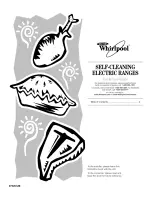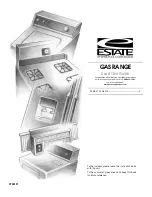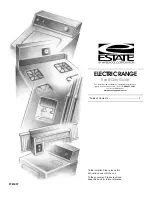
4
Electrical Requirements
If codes permit and a separate ground wire is used, it is
recommended that a qualified electrical installer determine that
the ground path and wire gauge are in accordance with local
codes.
Check with a qualified electrical installer if you are not sure the
range is properly grounded.
This range must be connected to a grounded metal, permanent
wiring system.
Be sure that the electrical connection and wire size are adequate
and in conformance with the National Electrical Code, ANSI/NFPA
70-latest edition or CSA Standards C22.1-94, Canadian Electrical
Code, Part 1 and C22.2 No. O-M91-latest edition, and all local
codes and ordinances.
A copy of the above code standards can be obtained from:
National Fire Protection Association
One Batterymarch Park
Quincy, MA 02269
CSA International
8501 East Pleasant Valley Road
Cleveland, OH 44131-5575
Electrical Connection
To properly install your range, you must determine the type of
electrical connection you will be using and follow the instructions
provided for it here.
■
Range must be connected to the proper electrical voltage and
frequency as specified on the model/serial number rating
plate. The model/serial number rating plate is located at the
bottom of the right-hand mounting rail. See the following
illustration.
■
Models rated from 12.7 kW at 240 volts (9.5 at 208 volts)
require a separate 50-amp circuit.
■
A time-delay fuse or circuit breaker is recommended.
■
Flexible cable from appliance should be connected directly to
the junction box.
■
Fuse both sides of the line.
■
Do not cut the conduit. The length of conduit provided is for
serviceability of the oven.
■
A UL listed or CSA approved conduit connector must be
provided.
■
If the house has aluminum wiring follow the procedure below:
1. Connect a section of solid copper wire to the pigtail
leads.
2. Connect the aluminum wiring to the added section of
copper wire using special connectors and/or tools
designed and UL listed for joining copper to aluminum.
Follow the electrical connector manufacturer's recommended
procedure. Aluminum/copper connection must conform with
local codes and industry accepted wiring practices.
Countertop Preparation
Front edges:
You may need to shave or cut the trim of formed or metal front-
edged countertops to clear the 30" (76.2 cm) width of the
cooktop.
If countertop thickness is more than 1
¹⁄₂
" (3.8 cm) thick:
Countertop must be notched as shown to avoid damaging the
oven control panel.
If countertop extends more than 1
¹⁄₈
" (2.9 cm) beyond cabinet
front:
Notch countertop as shown to clear oven control panels.
A. Model/serial number plate
A
A. Notch width to be equal on both sides
B. 30
¹⁄₈
" (76.5 cm) width
C. 1
¹⁄₂
" (3.8 cm) max.
A. Notch width to be equal on both sides
B. 30
¹⁄₈
" (76.5 cm) width
C. Cabinet front
D. 1
¹⁄₈
" (3.8 cm) max.
C
B
A
B
C
D
A


























